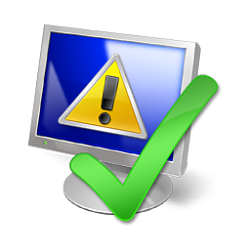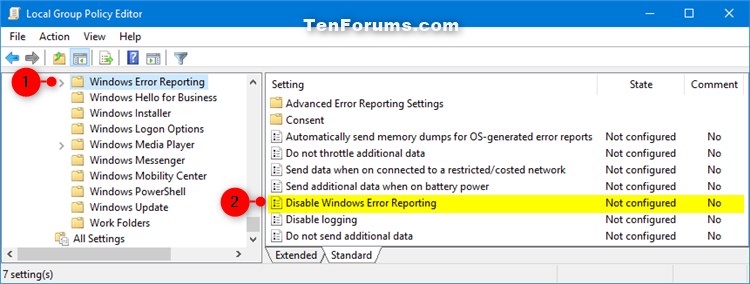How to Enable or Disable Windows Error Reporting in Windows 10
Windows Error Reporting (WER) is a flexible event-based feedback infrastructure designed to gather information about the hardware and software problems that Windows can detect, report the information to Microsoft, and provide users with any available solutions.
This tutorial will show you how to enable or disable Windows Error Reporting for your account, specific users, or all users in Windows 10.
Contents
- Option One: Turn On or Off Windows Error Reporting for Current User using a REG file
- Option Two: Turn On or Off Windows Error Reporting for All Users using a REG file
- Option Three: Enable or Disable Windows Error Reporting for All Users in Local Group Policy Editor
- Option Four: Enable or Disable Windows Error Reporting for Specific Users in Local Group Policy Editor
- Option Five: Enable or Disable Windows Error Reporting for All Users using a REG file
EXAMPLE: Windows Error Reporting enabled (on) and disabled (off)

The downloadable .reg files below will add and modify the DWORD value in the registry key below.
HKEY_CURRENT_USER\Software\Microsoft\Windows\Windows Error Reporting
Disabled DWORD
(delete) = On
1 = Off
1. Do step 2 (on) or step 3 (off) below for what you would like to do.
This is the default setting.
A) Click/tap on the Download button below to download the file below, and go to step 4 below.
Turn_ON_Windows_Error_Reporting_current_user.reg
Download
A) Click/tap on the Download button below to download the file below, and go to step 4 below.
Turn_OFF_Windows_Error_Reporting_current_user.reg
Download
4. Save the .reg file to your desktop.
5. Double click/tap on the downloaded .reg file to merge it.
6. When prompted, click/tap on Run, Yes (UAC), Yes, and OK to approve the merge.
7. You can now delete the downloaded .reg file if you like.
You must be signed in as an administrator to be able to do this option.
If turned off, this option will override Option One.
The downloadable .reg files below will add and modify the DWORD value in the registry key below.
HKEY_LOCAL_MACHINE\SOFTWARE\Microsoft\Windows\Windows Error Reporting
Disabled DWORD
(delete) = On
1 = Off
1. Do step 2 (on) or step 3 (off) below for what you would like to do.
This is the default setting.
A) Click/tap on the Download button below to download the file below, and go to step 4 below.
Turn_ON_Windows_Error_Reporting_all_users.reg
Download
A) Click/tap on the Download button below to download the file below, and go to step 4 below.
Turn_OFF_Windows_Error_Reporting_all_users.reg
Download
4. Save the .reg file to your desktop.
5. Double click/tap on the downloaded .reg file to merge it.
6. When prompted, click/tap on Run, Yes (UAC), Yes, and OK to approve the merge.
7. You can now delete the downloaded .reg file if you like.
You must be signed in as an administrator to be able to do this option.
If disabled, this option will override Option One, Option Two, and Option Four.
The Local Group Policy Editor is only available in the Windows 10 Pro, Enterprise, and Education editions.
All editions can use Option Five below.
1. Open the Local Group Policy Editor.
2. In the left pane of the Local Group Policy Editor, click/tap on to expand Computer Configuration, Administrative Templates, Windows Components, and Windows Error Reporting. (see screenshot below)
3. In the right pane of Windows Error Reporting, double click/tap on the Disable Windows Error Reporting policy to edit it. (see screenshot above)
4. Do step 5 (enable) or step 6 (disable) below for what you would like to do.
A) Select (dot) Not Configured or Disabled, click/tap on OK, and go to step 7 below. (see screenshot below)
Not Configured is the default setting.
7. When finished, you can close the Local Group Policy Editor if you like.
You must be signed in as an administrator to be able to do this option.
If disabled, this option will override Option One and Option Two.
The Local Group Policy Editor is only available in the Windows 10 Pro, Enterprise, and Education editions.
All editions can use Option Five below.
1. Open the all users, specific users or groups, or all users except administrators Local Group Policy Editor for how you want this policy applied.
2. In the left pane of the Local Group Policy Editor, click/tap on to expand User Configuration, Administrative Templates, Windows Components, and Windows Error Reporting. (see screenshot below)
3. In the right pane of Windows Error Reporting, double click/tap on the Disable Windows Error Reporting policy to edit it. (see screenshot above)
4. Do step 5 (enable) or step 6 (disable) below for what you would like to do.
A) Select (dot) either Not Configured or Enabled, click/tap on OK, and go to step 7 below. (see screenshot below)
Not Configured is the default setting.
7. When finished, you can close the Local Group Policy Editor if you like.
You must be signed in as an administrator to be able to do this option.
If disabled, this option will override Option One, Option Two, and Option Four.
The downloadable .reg files below will add and modify the DWORD value in the registry keys below.
HKEY_CURRENT_USER\Software\Policies\Microsoft\Windows\Windows Error Reporting
HKEY_LOCAL_MACHINE\SOFTWARE\Policies\Microsoft\Windows\Windows Error Reporting
Disabled DWORD
(delete) = Enable
1 = Disable
1. Do step 2 (enable) or step 3 (disable) below for what you would like to do.
This is the default setting.
A) Click/tap on the Download button below to download the file below, and go to step 4 below.
Enable_Windows_Error_Reporting_all_users.reg
Download
A) Click/tap on the Download button below to download the file below, and go to step 4 below.
Disable_Windows_Error_Reporting_all_users.reg
Download
4. Save the .reg file to your desktop.
5. Double click/tap on the downloaded .reg file to merge it.
6. When prompted, click/tap on Run, Yes (UAC), Yes, and OK to approve the merge.
7. You can now delete the downloaded .reg file if you like.
That's it,
Shawn Brink
Related Tutorials
- How to Change Windows Error Problem Reporting Settings in Windows 10
- How to View Reliability History in Windows 10
- How to Create a Reliability Monitor Shortcut in Windows 10
- How to Clear Reliability History in Windows 10
Enable or Disable Windows Error Reporting in Windows 10
-
New #1
Hello,
Thanks for this detailed tutorial, very useful.
However, I think there is an error on Option Three (Enable or Disable Windows Error Reporting for All Users in Local Group Policy Editor).
If you want to disable it you must set the policy to "Enabled" and if you want to enable it, you must set the policy to "Disabled" not the other way around.
-

Enable or Disable Windows Error Reporting in Windows 10
How to Enable or Disable Windows Error Reporting in Windows 10Published by Shawn BrinkCategory: Performance & Maintenance
12 Apr 2022
Tutorial Categories


Related Discussions








 Quote
Quote
